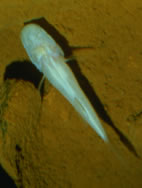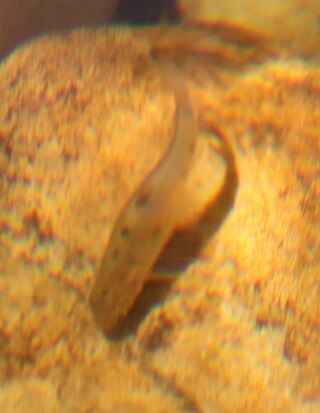The northern cavefish or northern blindfish is found in caves through Kentucky and southern Indiana. The International Union for Conservation of Nature lists the species as near threatened.

The Amblyopsidae are a fish family commonly referred to as cavefish, blindfish, or swampfish. They are small freshwater fish found in the dark environments of caves, springs and swamps in the eastern half of the United States. Like other troglobites, most amblyopsids exhibit adaptations to these dark environments, including the lack of functional eyes and the absence of pigmentation. More than 200 species of cavefishes are known, but only six of these are in the family Amblyopsidae. One of these, Forbesichthys agassizii, spends time both underground and aboveground. A seventh species in this family, Chologaster cornuta, is not a cave-dweller but lives in aboveground swamps.

The Ozark cavefish, Amblyopsis rosae, is a small subterranean freshwater fish endemic to the United States. It has been listed as a threatened species in the US since 1984; the IUCN currently lists the species as Near Threatened, though it was previously listed as Vulnerable between 1986 and 1996. It is listed as Endangered and Threatened by the Missouri Department of Conservation.

The Alabama cavefish is a critically endangered species of amblyopsid cavefish found only in underground pools in Key Cave, located in northwestern Alabama, United States in the Key Cave National Wildlife Refuge. It was discovered underneath a colony of gray bats in 1967 by researchers Robert A. Kuehne and John E. Cooper and scientifically described in 1974.
The Somalian blind barb is a ray-finned fish species in the family Cyprinidae. It is the only member of the genus Barbopsis. This troglobitic fish is found only in Somalia.
Caecobarbus geertsi, the African blind barb or Congo blind barb, is a species of cyprinid fish. This threatened cavefish is only known from Democratic Republic of the Congo, and it is the only member of the monotypic genus Caecobarbus. George Albert Boulenger described this fish in 1921 and it apparently lacks any close relatives in the Congo region.

Garra andruzzii, a species of cyprinid fish, formerly the only species of the genus Phreatichthys, and is endemic to Somalia. This cave-adapted fish is whitish and blind. It has no scales. It is considered to have evolved in the cave environment for some two million years. Its former generic name derives from the Greek words phreasatos for spring, and ichthys for fish. It grows to a maximum length of 6.2 cm (2.4 in).

The Berg River redfin or Berg redfin is an African freshwater fish species in the family Cyprinidae. The Burchell's redfin, the type species of its genus Pseudobarbus, is a very close relative. The Berg River redfin is tetraploid.
Speonectes tiomanensis is a species of stone loach that is endemic to Malaysia and only known from a cave on Tioman Island. This fish reaches a length of 5.8 centimetres (2.3 in) SL. This species is the only known member of its genus, but it was formerly included in Sundoreonectes. It is the only cavefish known from Malaysia.
Prietella is a small genus of North American freshwater catfishes found in Mexico and Texas, and restricted to underground waters.
The Andean catfish is a species of freshwater fish in the family Astroblepidae. The Spanish name for the Andean catfish is preñadilla. It is endemic to the highlands of the Ecuadorian Andes where it lives in mountain streams in four different drainage basins in the Imbakucha watershed. It is a brownish-grey fish growing to about 150 mm (6 in). The fish is threatened by human activities in the area with loss and fragmentation of its habitat, and the International Union for Conservation of Nature has assessed its conservation status as being "critically endangered".

Clarias maclareni is a critically endangered species of catfish in the family Clariidae. It is endemic to Lake Barombi Mbo in western Cameroon. It is currently threatened because of pollution and sedimentation due to human activities, and potentially also by large emissions of carbon dioxide (CO2) from the lake's bottom (compare Lake Nyos). It is known to grow to 36 centimetres (14 in) TL. Large individuals feed mainly on other fishes (especially cichlids), while smaller individuals mainly feed on insects.
Ogilbia galapagosensis, the Galapagos cuskeel, is a species of fish in the family Bythitidae. It is only known from four brackish-water cave systems on Santa Cruz Island, Galápagos, Ecuador. Although usually called a cavefish, it has been argued that this label is inaccurate, as the places it inhabit also can be described as lagoon crevices.

Typhleotris madagascariensis is a species of fish in the family Milyeringidae that is endemic to Madagascar, where it is only known from underground waters in the southwestern portion of the island. This cavefish is blind and lacks pigmentation, and can reach a standard length of 8 cm (3.1 in).

Typhlichthys subterraneus, the southern cavefish, is a species of cavefish in the family Amblyopsidae endemic to karst regions of the eastern United States.

Uegitglanis zammaranoi is the only species of catfish in the genus Uegitglanis of the family Clariidae. It is endemic to Somalia, where it only occurs in caves near the Jubba and the Shebelle Rivers. This species grows to about 10.1 cm (4.0 in) in total length.

Cavefish or cave fish is a generic term for fresh and brackish water fish adapted to life in caves and other underground habitats. Related terms are subterranean fish, troglomorphic fish, troglobitic fish, stygobitic fish, phreatic fish, and hypogean fish.
Poropuntius speleops is a vulnerable species of ray-finned fish in the genus Poropuntius. It is found only in underground streams in a single cave in the Phu Khieo Wildlife Sanctuary in Thailand. Like other cavefish, it has reduced pigmentation and eyes. It is threatened by poaching for food and the aquarium trade, although the population is stable.

Astroblepus pholeter is a species of catfish of the family Astroblepidae. This cavefish is endemic to the Jumandi Cave in the Napo River basin in Ecuador.










